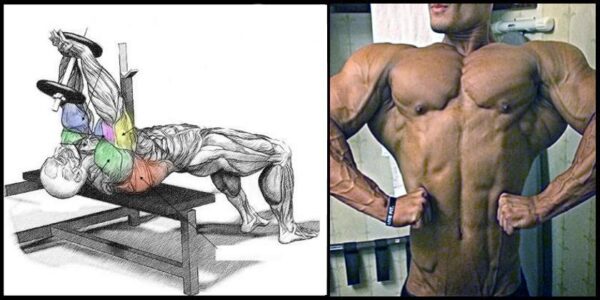Hit Your Pecs and Back Real Hard with Straight Arm Dumbbell Pullovers
Upper body heavy dumbbell training has always been a staple in old school bodybuilding workout programs. Building the upper body muscles has always been a matter of putting in hard work and being determined and mentally strong to endure the heavy resistance that free weights provide, not workout machines.
They do offer their own unique benefits, but the muscles are forced to move in the machine’s planes of movement, which are mostly unnatural and can hardly substitute the muscles natural ranges of movement. This article is not meant for those who think they have found success using machines exclusively, are satisfied with their current results or aren’t interested in exploring new ways of training. But for those who are continuously striving to find new ways to improve their upper body and overall physique and take it to the next level, plus, have the mental fortitude to face a new hard and exciting physical challenge, we’ve found an exercise that will do just that.
We’re talking about straight-arm dumbbell pullovers.
How do they affect the muscle structure?
Straight arm dumbbell pullovers will stimulate both pectoralis major and minor, the latissimus dorsi, as well as the smaller serratus anterior muscles, which will put the pecs and lats in the spotlight looking from the front. This results in an upper body attack from all angles that will make your chest wider and add thickness to your shoulders and the back.
The muscle fibers in the latissimus dorsi extend from the lower thoracic vertebrae, and the iliac crest in the hip, and then they join at the upper part of the humerus in the upper arm next to the shoulder. Latissimus dorsi extends the humerus bone by dragging the upper arm in a backward motion. Additionally, it causes an adduction of the humerus bone by getting the arm back to the body center. When your arms get directly overhead like they do in this exercise’s range of motion, greatest activation is achieved in the lower and middle parts of the lats.
The bigger part of the chest muscle, the pectoralis major is also stimulated when the dumbbell is moved from the overhead position to the position over the chest. This muscle runs from your clavicle, manubrium which is the top part of the sternum, the upper costal cartridges and the upper area of the external obliques to the head of the humerus of your upper arm next to the shoulder joint. The pectoralis major muscle adducts your bone, which is basically drawing the arm to the middle of the body.
The serratus anterior is attached to the ribs’ lateral side. The muscle fibers of serratus anterior are anchored on the first eight ribs, after which they are posteriorly positioned at the thorax’s lateral side. Its other end attaches at the scapula’s medial border. It protracts the scapula (pulls it forward) and holds it against the wall of the thorax, which is very important in throwing and pushing movements.
Your abs act as stabilizers to the upper body muscles while doing pullovers. The rectus abdominis is positioned from your pelvis to the sternum base. The external oblique muscles are positioned from the 5th to the 12th rib, downward to the pubic area and the pelvis’ iliac bones. When the right and left side of the external obliques and rectus abdominis are shortened, they are flexing the trunk in a way that the head goes in the direction of the feet.

